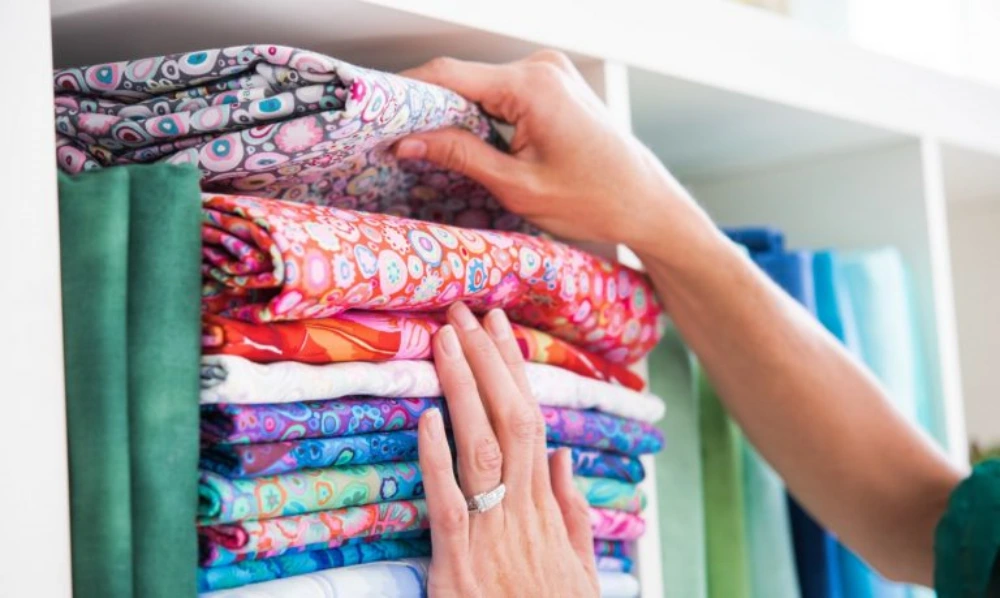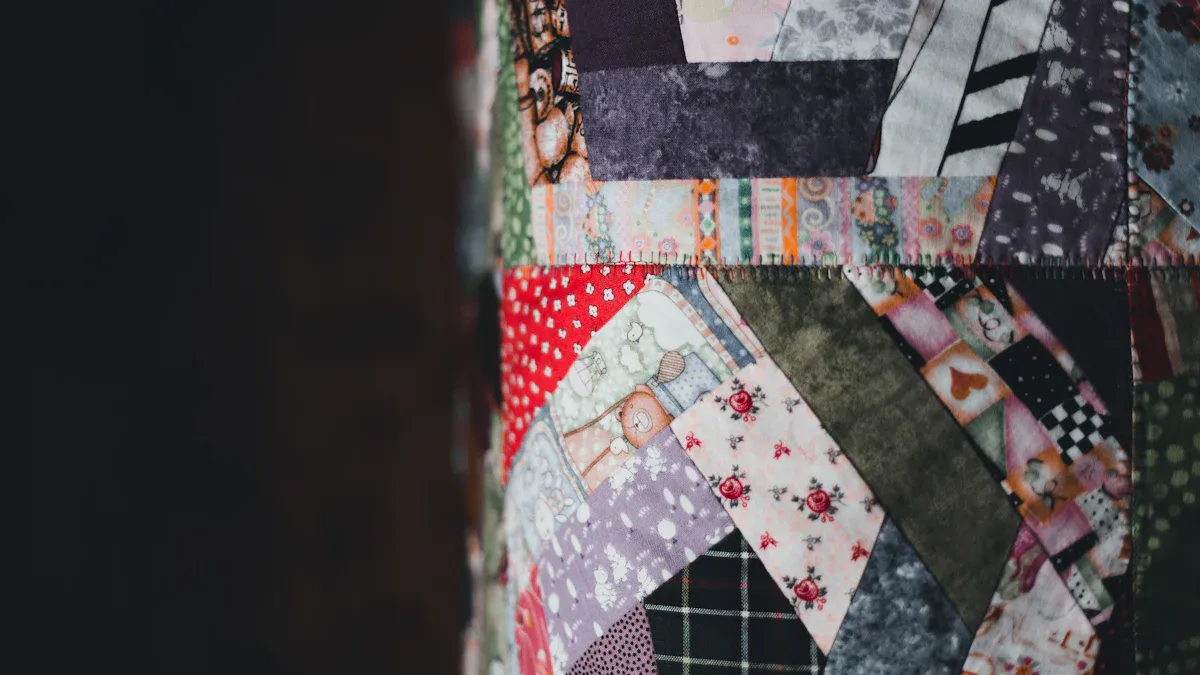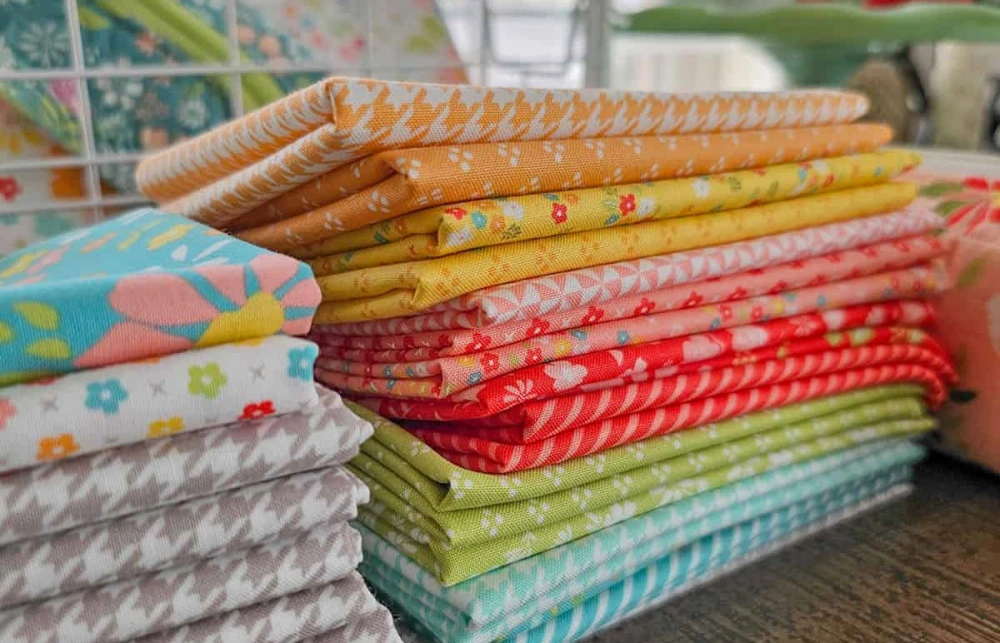
Looking for the best fabric for quilt backing in 2025? Here are the top picks you’ll love:
100% cotton (a favorite for its feel and quality)
Wide backing fabrics (like those from Fanda Fabrics)
Flannel, minky, linen blends, and even recycled materials
Quilters rave about the comfort and durability of cotton, and you’ll find wide cotton options from big names and trusted brands.
New collections and innovative backing fabric designs hit the market this year, making it even easier to find the best backing for a quilt. Fanda Fabrics brings you premium quilt backing with plenty of choices to match your style and project size.
Key Takeaways
Choose high-quality quilt backing like 100% cotton for comfort, durability, and easy care.
Use wide backing fabrics, such as those from Fanda Fabrics, to avoid seams and get a smooth, professional finish.
Prewash your quilt backing fabric to prevent shrinkage and color bleeding before sewing.
Select backing fabrics like flannel or minky for extra warmth and softness, perfect for cozy quilts.
Measure your quilt top carefully and add extra inches to ensure the backing fits well and stays in place.
Why Quilt Backing Matters?

Comfort and Durability
When you pick quilt backing, you set the stage for how your quilt will feel and last. Think of quilt backing as the foundation. It covers the largest area and takes the most wear. If you want your quilt to become a family treasure, you need to choose high-quality quilt backing.
Many quilters love 100% cotton for this reason. Cotton feels soft, breathes well, and stands up to years of washing. Textile experts say cotton backing lasts about 40% longer than synthetics. You also get a cozy, comfortable quilt that feels great against your skin.
If you plan to use your quilt every day, you might want heavier cotton or even denim for extra strength. Wide quilt backing, especially in 108-inch or 118-inch widths, helps you avoid seams. Fewer seams mean fewer weak spots and a smoother finish.
Most professional quilters recommend wide quilt backing for this reason. When you prepare your quilt backing by prewashing and ironing, you help prevent shrinkage and keep your quilt looking its best.
Tip: Always extend your quilt backing a few inches beyond the quilt top. This makes quilting easier and helps keep everything in place.
Visual Impact
Quilt backing does more than just hold your quilt together. It can change the whole look and feel of your finished project. You can use quilt backing to add a pop of color, a fun print, or even a creative pieced design.
Some quilters match the backing to the quilt top for a seamless look. Others pick bold or contrasting colors to make the back just as exciting as the front.
The material you choose for quilt backing also affects the visual and tactile appeal. Flannel or minky can make your quilt feel extra soft and cuddly. If you want your quilt to stand out, try using a two-tone or scrappy quilt backing. The right choice can turn your quilt into a true work of art, both front and back.
How to Select Quilt Backing?
Choosing the right quilt backing can make your project shine and last for years. Let’s break down what you need to know so you can select quilt backing with confidence.
Fabric Quality and Width
When you pick quilt backing, always start with quality. Professional quilters suggest feeling the fabric in your hands. Softness, drape, and durability matter most. You want a backing fabric that feels good and stands up to washing. Pre-wash your fabric to avoid shrinkage later. Check the grain so your quilt backing lies flat and hangs straight.
Width is another big factor. Standard widths range from 36 inches for small projects to 120 inches for the largest quilts. Here’s a quick look:
Fabric Width (inches) | Best Use |
|---|---|
36 | Small projects, piecing needed |
44/45 | Most common, piecing for large quilts |
60 | Larger quilts, fewer seams |
90 | Medium quilts, less piecing |
108 | Seamless backs for big quilts |
118/120 | Extra-wide, perfect for king-size quilts |
Wide quilt backing, like the 118-inch options from Fanda Fabrics, saves you time and gives a smooth, professional finish.
Matching to Quilt Top
You want your quilt backing to look as good as the front. Try to match colors or pick prints that blend with your quilt top. Many quilters use wide backing fabrics with blender-style prints or dominant colors from the quilt.
You can even use the same fabric as your border for a coordinated look. If you want to hide stitching imperfections, busy prints work well. For a bold statement, choose a contrasting color or large motif.
Tip: Large prints on the back can show off your quilting stitches or mask little mistakes.
Sizing and Sourcing
Measure your quilt top and add 4 to 8 inches to each side. This extra space helps with shifting during quilting and finishing. For example, if your quilt top is 99 by 106 inches, you’ll want backing at least 103 by 110 inches. Wide quilt backing means you buy less yardage and avoid seams.
Finding high-quality quilt backing is easier now. Fanda Fabrics offers customizable, premium options in many widths and materials. You can order just what you need, even for big projects. Many quilters struggle with color matching and storage, but shopping with trusted brands like Fanda Fabrics helps you get the right fabric quickly and easily.
Best Fabric for Quilt Backing in 2025

Choosing the best fabric for quilt backing can feel overwhelming, but you have more great options than ever in 2025. Let’s break down what makes each type stand out so you can pick the right one for your next project.
100% Cotton
You can never go wrong with 100% cotton for quilt backing. Quilters love it for its comfort, breathability, and classic feel. Cotton comes in a huge range of colors and prints, so you can always find something that matches your quilt top or adds a fun surprise on the back. It’s easy to sew and holds up well over time.
Here’s a quick look at the pros and cons:
Advantages of 100% Cotton Quilt Backing | Disadvantages of 100% Cotton Quilt Backing |
|---|---|
Highly absorbent and breathable, enhancing comfort | Tends to shrink, requiring pre-washing |
Durable and long-lasting | Can experience color bleeding if not pre-washed separately |
Available in a wide variety of colors and patterns, allowing aesthetic versatility | Prone to pilling and bearding over time, which may affect appearance |
Easy to care for and resists wrinkling | Requires careful maintenance to avoid shrinkage and color issues |
Comfortable and versatile, favored by many quilters |
If you want the best fabric for quilt backing that’s reliable and easy to care for, cotton is a top pick. Just remember to prewash it to avoid shrinkage and color bleeding.
Wide Backing (Fanda Fabrics)
Wide backing fabrics have changed the game for quilters, especially if you love making large quilts. Fanda Fabrics offers some of the best fabrics for quilt backing with their 118-inch wide Quilt Backing Fabric and Wide Back Quilting Fabric. These options give you a seamless, professional finish every time.
Why do so many quilters choose wide backing from Fanda Fabrics?
You get fabric up to 118 inches wide, so you don’t need to piece together smaller widths.
The seamless design means no bulky seams or distracting stitching lines on the back.
It saves you time and effort, especially for king or super-king quilts.
Fanda Fabrics lets you customize the color of the backing fabric, pattern, and even the material—choose from 100% cotton, flannel, or blends.
The high-quality materials feel soft, last long, and look beautiful.
You can order exactly what you need, whether you want a bold print or a subtle solid.
If you want the best backing for a quilt that looks flawless and feels luxurious, wide backing from Fanda Fabrics is hard to beat.
Tip: Wide backing is perfect for anyone who wants a smooth, professional look without extra work.
Flannel
Flannel quilt backing is all about warmth and coziness. If you want a quilt that feels like a big hug, flannel is your friend. Many quilters use flannel for winter quilts or throws because it traps heat and feels soft against the skin.
Here’s what you’ll notice with flannel:
Flannel makes quilts extra warm, especially when you pair it with wool batting.
It adds weight, which can make the quilting process a bit more challenging.
Flannel wears well, but if you skip batting, it might wear out faster at the seams.
Pet hair can stick to flannel, but not much more than other fabrics.
Flannel is a great choice for fleece quilt backing if you want that plush, snuggly feel.
If you want a quilt that keeps you warm all winter, flannel is one of the best fabric for quilt backing choices.
Minky
Minky brings a whole new level of softness to quilt backing. This plush, velvety fabric is a favorite for baby quilts and anyone who loves a cuddly finish. Minky comes in wide widths, so you can often avoid seams.
Here’s what makes Minky special:
Minky feels soft and luxurious, making your quilt extra cuddly.
It comes in 60″ and 90″ widths, so you can use it for larger quilts without piecing.
The fabric doesn’t fray, which makes binding easier.
Minky has a nap (directional pile), so you need to pay attention to the direction when sewing.
It’s stretchy and slippery, so take your time when cutting and sewing. Use a walking foot and stretch needle for best results.
Minky sheds at first, but this stops after the first wash.
You don’t need to prewash minky, and it pairs well with bamboo batting for a soft, drapey quilt.
If you want a fleece quilt backing that’s even softer, minky is a great pick.
Keep in mind, minky is synthetic, so wash it less often to reduce microfiber pollution.
Linen Blends
Linen blends offer a unique texture and breathability for quilt backing. If you want something that feels a little different and looks elegant, linen blends are worth a try.
Feature | 100% Linen | Linen Blends |
|---|---|---|
Breathability | Excellent | Good to fair |
Texture (Softness) | Gets softer over time | Softer initially but may not improve |
Wrinkle Resistance | Wrinkles easily | May wrinkle less |
Linen blends combine linen with cotton or polyester, so you get a softer feel right away and less wrinkling than pure linen. They breathe well and add a touch of luxury to your quilt. If you want the best fabric for quilt backing that stands out, linen blends are a stylish choice.
Recycled Materials
If you care about sustainability, recycled materials are making a big impact in quilt backing. Modern recycled fabrics use post-consumer polyester and other fibers to create durable, eco-friendly options.
Here’s why recycled materials are gaining popularity:
Many recycled quilt backings use up to 80% post-consumer polyester, verified by global standards.
These fabrics are lightweight, durable, and breathable—great for everyday quilts.
They support a circular economy, reducing waste and promoting renewable resources.
Recycled backing fabric often comes in nonwoven styles, which resist wear and provide stability.
You can find recycled options that are PVC-free and certified for sustainability.
If you want the best fabric for quilt backing that’s good for the planet and performs well, recycled materials are a smart pick.
Note: No matter which fabric you choose, always consider the size of your quilt, the feel you want, and how much care you’re willing to give. The right quilt backing can turn a good quilt into a great one!
Quilt Backing Comparison
Quick Reference Table
When you’re picking quilt backing, it helps to see how the top fabrics stack up side by side. Here’s a handy table that compares cost, feel, and durability for some of the most popular choices in 2025. This way, you can quickly spot which quilt backing fits your needs and budget.
Fabric Type / Brand | Cost Range (per yard) | Feel Characteristics | Durability Factors |
|---|---|---|---|
Organic Cotton | $10 – $20 | Soft, sustainable, great stitch definition | Durable, eco-friendly |
Supima Cotton | $12 – $25 | Extra soft, holds color well | Long fibers, very durable |
Moda Fabrics | $15 – $30 | Vibrant, soft, detailed patterns | Consistent quality, long-lasting |
Robert Kaufman Fabrics | $12 – $25 | Soft, vibrant colors | Keeps color, strong fibers |
Liberty Fabrics | $18 – $35 | Fine, rich colors, detailed designs | Premium quality, very durable |
Michael Miller Fabrics | $16 – $30 | Soft, colorfast | Reliable for lasting quilts |
Riley Blake Designs | $14 – $26 | Vibrant, soft, easy to work with | Durable, user-friendly |
Linen Blends | $14 – $28 | Textured, breathable, elegant | Strong, less prone to wrinkling |
Minky | $12 – $22 | Plush, velvety, super soft | Durable, resists pilling |
Recycled Materials | $10 – $20 | Lightweight, smooth, eco-friendly | Good durability, sustainable |
Flannel | $9 – $18 | Warm, cozy, soft | Wears well, especially with batting |
Tip: For the best quilt backing, look for a thread count between 200 and 300. This gives you a soft feel and strong fabric that lasts.
You might also want to keep these quick facts in mind when choosing your quilt backing:
Yardage conversions help you buy the right amount of fabric.
Precut fabric sizes like fat quarters and jelly rolls save time.
Standard quilt and mattress sizes guide your fabric needs.
Wide backing fabric measurements make it easy to cover large quilts without seams.
With this table and these tips, you can confidently pick the perfect quilt backing for your next project.
Expert Tips for Quilt Backing
Prewashing and Care
You want your quilt backing to look great and last a long time. Prewashing is a smart first step. Always wash your fabric before you cut it. This removes any chemicals and helps prevent shrinkage later. Use cool or warm water with a mild detergent. If you’re working with dark or bright colors, toss in a color catcher sheet to stop color bleeding.
Dry your fabric on low heat to keep it from shrinking too much or getting wrinkled. For best results, sort your fabrics by color before washing. If you have small pieces, skip prewashing to avoid fraying and fabric loss. After washing, press your fabric while it’s still a little damp. This makes it easier to cut and sew.
Tip: Prewashing your quilt backing means fewer surprises after your quilt is finished!
Seamless Backing
A seamless quilt backing gives your project a smooth, professional look. Wide backing fabrics, like those from Fanda Fabrics, make this easy. You don’t have to piece together smaller sections, so you avoid bulky seams and uneven stitching.
When you use wide quilt backing, your quilt lies flat and looks polished from every angle. Always square up your fabric along the grain before you start. This helps prevent sagging and keeps your quilt backing flat. If you do need to join pieces, use a larger seam allowance and press the seams open to reduce bulk.
Using seamless quilt backing not only looks better but also helps your quilt last longer.
Avoiding Common Mistakes
It’s easy to make small mistakes with quilt backing, but you can avoid them with a few simple habits:
Always allow 6-8 inches of extra quilt backing on all sides of your quilt top. This gives you room for quilting and prevents puckering.
Don’t use synthetic sheets as backing. They can shift and cause tension problems.
Remove selvages before sewing pieces together. If you can’t, make relief cuts every few inches to prevent puckering.
Press seams open and orient them parallel to the quilting direction for a flat finish.
Double-check your measurements before cutting. Proper sizing saves you time and frustration.
Remember, choosing high-quality, wide quilt backing from Fanda Fabrics helps you avoid many of these issues and gives your quilt a flawless finish.
Conclusion
You have so many great choices for quilt backing in 2025. Quilting cottons give you stability and easy care, while flannel and minky add warmth and softness.
Wide back fabrics from Fanda Fabrics make your projects look seamless and professional. Think about what your quilt needs—comfort, durability, or a bold look. When you want premium options and custom sizes, Fanda Fabrics has you covered.
Ready to start your next quilt? Explore more beautiful backing fabrics at Fanda Fabrics and get inspired!
FAQ
What is the best width for quilt backing?
You want your backing to be at least 4–8 inches wider and longer than your quilt top. Wide backing fabrics, like 108″ or 118″ from Fanda Fabrics, make it easy to cover large quilts without seams.
Do I need to prewash quilt backing fabric?
Yes, you should prewash your quilt backing. This helps prevent shrinkage and color bleeding later. Wash with cool or warm water and a mild detergent. Press the fabric while it’s still a little damp for best results.
Can I use different fabrics for the front and back of my quilt?
Absolutely! You can mix and match fabrics. Many quilters use cotton on the front and flannel or minky on the back for extra softness. Just make sure both fabrics have similar care instructions.
How do I avoid seams in my quilt backing?
Choose extra-wide backing fabric. Fanda Fabrics offers 118″ wide options, so you don’t need to piece smaller widths together. This gives your quilt a smooth, professional look and saves you time.
Where can I find premium quilt backing fabrics?
You can find high-quality, customizable quilt backing at Fanda Fabrics. They offer a wide range of materials, colors, and patterns to fit any project. You can order exactly what you need, even for large quilts.
